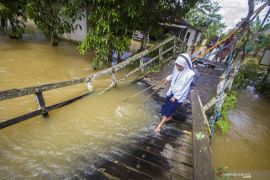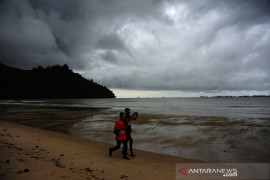We did this by mapping regions that are vulnerable to flooding, prepared an early warning system, routinely monitored climate information from BMKG (Meteorology, Climatology and Geophysics Agency), and prepared the La Nina Brigade movementJakarta (ANTARA) - The Ministry of Agriculture has readied several precautionary measures against the impact of La Nina weather pattern that could lead to harvest failure for rice due to the earlier rainy season and increasing rainfall.
During a hearing with the Commission IV of the House of Representatives (DPR), here on Monday, Vice Minister of Agriculture Harvick Hasnul Qolbi clarified that the Ministry of Agriculture had prepared short- and medium-term precautionary measures against La Nina.
"We did this by mapping regions that are vulnerable to flooding, prepared an early warning system, routinely monitored climate information from BMKG (Meteorology, Climatology and Geophysics Agency), and prepared the La Nina Brigade movement," Qolbi elaborated.
In addition, the ministry had provided free seed assistance for planting at most 20 days after flooding and prepared a tertiary irrigation network.
Qolbi noted that his group had disseminated information on the use of water-submergence resistant rice seed varieties, such as Inpari 1 to 10, Inpari 29, Inpari 30, Ciherang Sub 1, Inpari 42 Agritan, and other local varieties.
Related news: Disasters in August 2021 afflicted greater destruction than 2020: BNPB
This aims to ensure that rice crops remain productive despite the impact of La Nina at the end of the year in Indonesia, he added.
Other precautionary measures against La Nina entail the dissemination of Rice Farming Business Insurance (AUTP) and the use of seed aid as well as optimizing preparations for post-harvest by using drying machine and modern rice grinding machine.
For medium-term or permanent precautionary measures, the ministry had constructed or rehabilitated tertiary irrigation canal and water reservoirs as well as strengthened the People's Business Credit (KUR) for farming, the vice minister stated.
Related news: Rainfall, drought among largely reported natural disasters in Aug BNPB
According to the BMKG data, the rainy season is forecast to start in September in central to south of Sumatra and central Kalimantan.
However, most of Indonesia will experience the rainy season in October in half of Sumatra, Kalimantan, and Sulawesi, as well as most parts of Java and Bali, in addition to North Maluku and central Papua.
Meanwhile, the rainy season was projected to peak in January 2022 in most of Indonesia.
Related news: President Jokowi inaugurates Pasar Rumput apartments
Related news: 3rd batch of US-donated 1.1-million Pfizer doses arrive in Indonesia
Translator: Aditya R, Fadhli Ruhman
Editor: Fardah Assegaf
Copyright © ANTARA 2021










